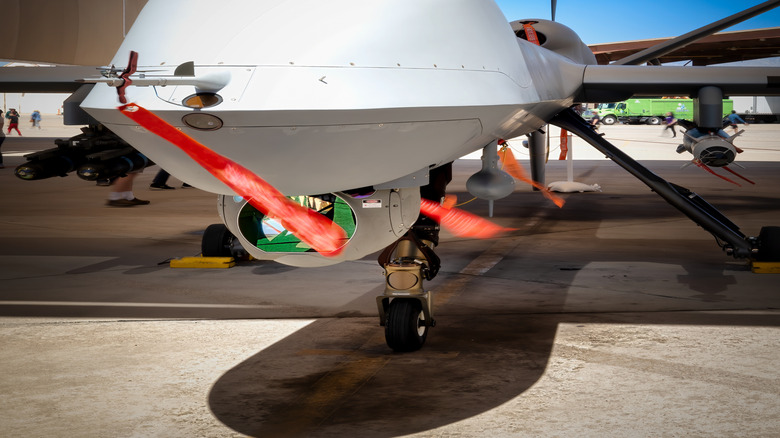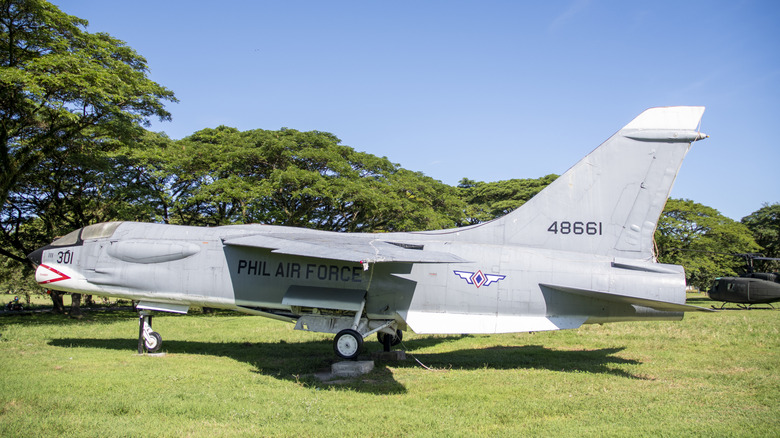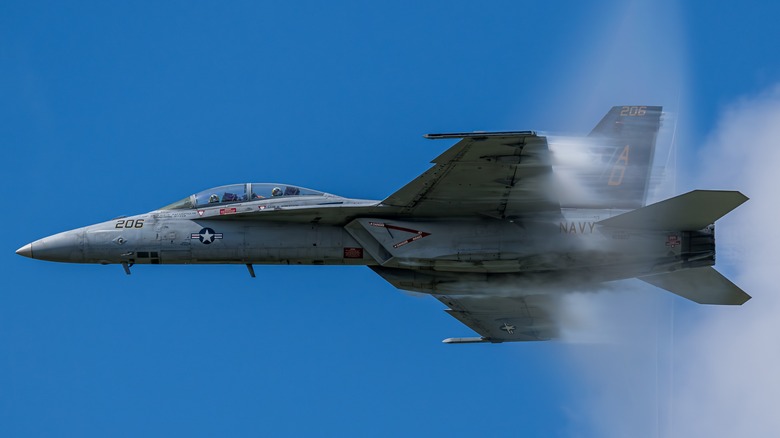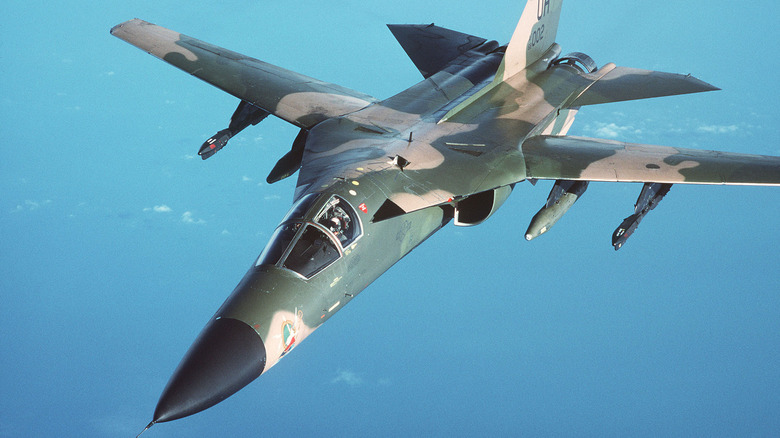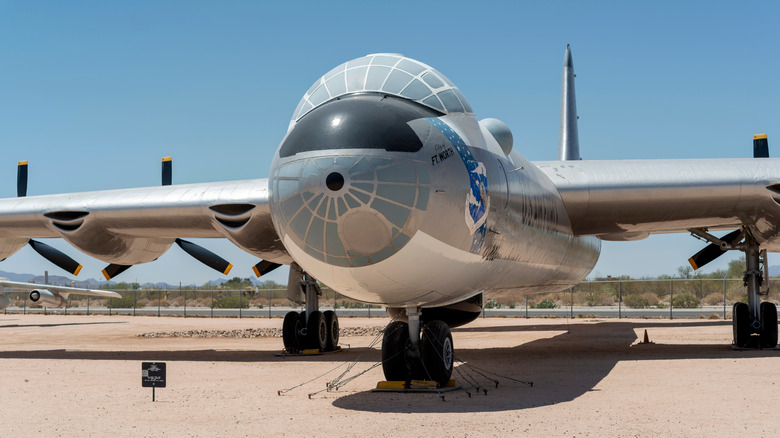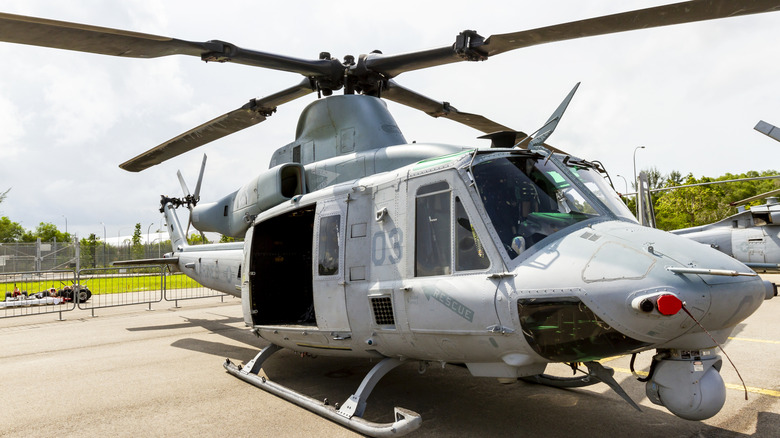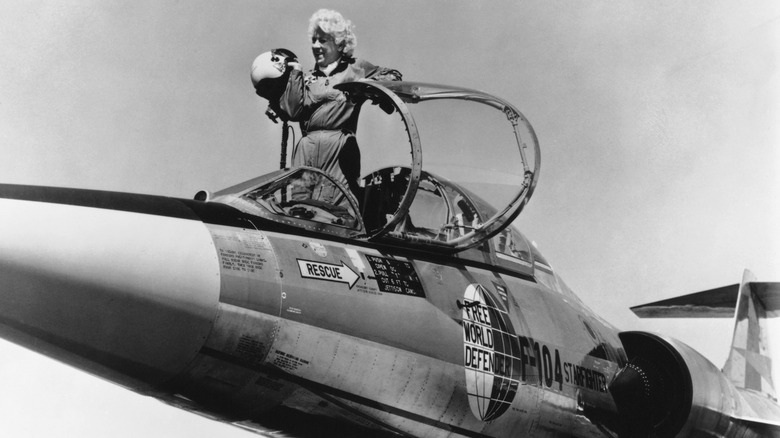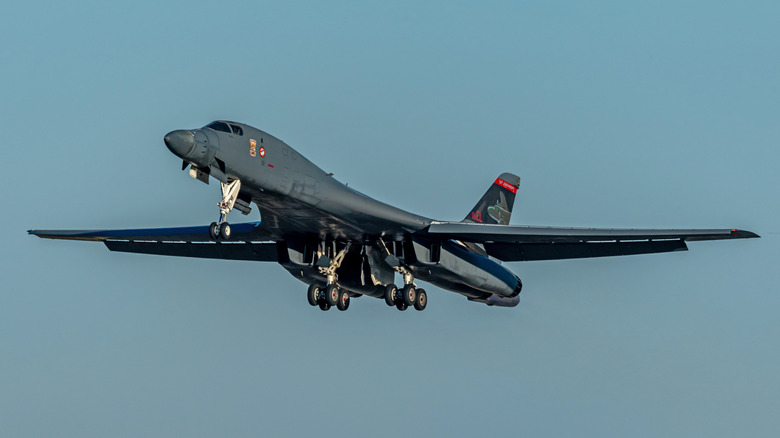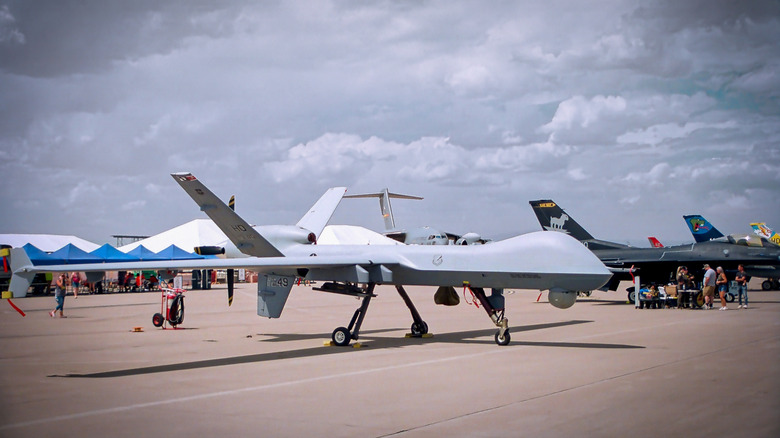Popular US Military Aircraft Nicknames (And The Stories Behind Them)
Where would militaries around the world be without their vehicles? From formidable weapons like heavy tanks to life-saving transports and speedy reconnaissance machines, they serve in a huge range of invaluable roles in warfare, making them staunch allies just like the humans that occupy them. In that spirit of closeness and comradeship, some vehicles have been given affectionate nicknames by crews and other military members — in aviation in particular.
Both military and civilian aircraft have been given creative nicknames, whether inspired by unique aspects of their appearance, their reputation, their capabilities, or something else. Some are official monikers that become part of an aircraft's designation, while others aren't. For instance, the legendary Concorde was so far ahead of its time that it could speed across time zones and land "before" it was scheduled to take off (locally speaking). As such, it came to be nicknamed the Time Machine.
Some similarly extraordinary military aircraft have also been given inspired nicknames, and we're going to take a look at some of the U.S. military's best. It's sometimes unclear where these nicknames came from, so it's important to shed some light on the stories behind them, too: the F-111, known as both "Aardvark" and "Whispering Death"; the fighter jet that proudly boasted the supercool nickname "Last of the Gunfighters"; and much more.
Last Of The Gunfighters: Vought F-8 Crusader
Early in World War I, pilots determined to shoot down enemy planes could only make erratic, very dangerous attempts to do so using handheld weapons like rifles. Later in the conflict, aircraft were equipped with so-called interruptor gears, paired with mounted machine guns. Now pilots could unleash a torrent of bullets from their planes with a reasonable degree of accuracy, and with the shots timed so as not to collide with their own propellers.
By the 1960s, though, fighters equipped with guns must have seemed rather primitive. The Vietnam War was the era of formidable U.S. aircraft like the F-4 Phantom II, bristling with air-to-ground weapons like Mk 117 bombs and air-to-air armaments like AIM 9-B Sidewinder missiles. The F-8 Crusader, designed by Chance-Vought in 1952 in response to the Navy's call for a new fighter to operate from aircraft carriers, was something of a throwback to that earlier time — its primary weapons were not state-of-the-art missiles, but a quartet of sizable 20mm guns (plus a limited stock of AIM-9 missiles).
For this reason, and as other armaments became increasingly prominent, the Crusader was given a nickname Clint Eastwood would be proud of: the Last of the Gunfighters. This also makes the Crusader's performance all the more impressive: It proved the deadliest U.S. fighter early in the Vietnam conflict, downing 18 planes while losing only three. The wider F-8 family wouldn't cease service until RF-8G recon models were retired in 1987.
Rhino: F-18 Super Hornet
Animal-related nicknames and designations have a way of giving an aircraft quite the fearsome image — depending on the animal chosen, naturally. "Super Hornet" is more than effective in evoking the image of a relentless, powerful menace from the skies, but the F-18 added the name of another formidable animal: Rhino.
The Super Hornet is an upgraded version of the original Hornet, created by McDonnell Douglas and first operated by the Marine Corps in 1983. A potent, versatile tool, it was equipped with the specs and weaponry to serve a range of roles, rather than just being a fighter.
The following decade, this fearsome aircraft was upgraded into the Super Hornet, debuting in 1995. What made it super? It could achieve a range of 1,458 miles instead of the legacy Hornet's 1,252 miles, giving it more flexibility in operations. It array of weapons was super, too: It can unleash fury on the land, in the sea, and in the air, by means of AIM 7 Sparrow and AIM 9 Sidewinder missiles, a Vulcan 20mm cannon, Paveway laser-guided bombs, Maverick missiles and more. In the power stakes, comparisons between the Super Hornet and a rampaging rhino are justified, but this isn't the primary reason for the nickname.
It's a heavier, more powerful model than the original, and it had a very distinctive raised feature on its radome, the housing that holds the radar antenna. This gives it something of a rhino-horn nose.
Aardvark and Whispering Death: The F-111
On the subject of members of the animal kingdom with distinctive noses, the majestically snouted aardvark has also lent its name to a jet of the U.S. military. This model, the F-111, was another Cold War powerhouse. At 73 feet, 6 inches long and 17 feet high, it was formidable, with two TF30-P-111 engines offering a combined 50,200 pounds of thrust and powering it to speeds just short of Mach 1.9.
It proved an essential weapon during conflicts from 1967 to 1996, with the 111F using Pave Tack infra-red technology to detect and identify priority targets from Vietnam to Libya and the Gulf War. The Aardvark, you might say, had an uncanny ability to sniff them out. Aside from its prominent nose, it also boasted then-innovative technology in a guidance system that let it follow the lay of the land, in a manner reminiscent of its snuffling mammal namesake.
Though Aardvark is a more literal, descriptive term, it doesn't really serve to intimidate or give much of an impression of the plane's capabilities. A far more imposing nickname, "Whispering Death," was given to the F-111 by the North Vietnamese forces that faced it. The aircraft had versatility, ferocity, maneuverability, and a wide selection of armaments: its original Vulcan cannon could be augmented with a selection of two dozen other bombs or missiles, including nuclear weapons. It could serve either a fighting or bombing role, earning the plane its menacing moniker.
Six Turning, Four Burning: B-36 Peacemaker
A bigger payload means a stronger and potentially more varied, versatile arsenal. But it also means more weight for a plane to carry. There's a good reason why bombers and fighters have historically tended to be very different in size and weight.
For the hefty B-36 Peacemaker, manufacturer Convair's solution to the issue of providing enough power to a bomber was a novel one: a whole array of engines. The B-36, which was just over 162 feet long and had a wingspan of 230 feet, was America's biggest military aircraft yet when it arrived in 1948. Convair created the design to try fulfilling the requirement for a bomber with intercontinental range. To carry what would ultimately be a payload of 86,000 pounds such distances at a practical speed, the B-36 Peacemaker had an unprecedented 10 engines.
These engines gave the aircraft its curious nickname of "Six Turning, Four Burning." It boasted four jet engines, J47s developed by General Electric, and six radial R-4360 engines of Pratt & Whitney design. The latter six would "turn" — that is, the articulating rods turn around the single master rod connected to the hub of the crankshaft — and the four General Electric engines would "burn," increasing its speed. The Peacemaker didn't always have six turning and four burning while in flight, but when it did, it could push itself to 435 mph.
Super Huey: The UH-1Y
Some of the most notable aircraft in the U.S. military, and those around the world, are jets. Stealth jets, fighters and multi-mode attack planes are some of the most iconic, often seen showing off their remarkable agility and prowess at air shows. As one example, the Thunderbirds are mainstays of such events.
But we can't forget the airplane's blade-whirling cousin, the helicopter. Choppers have long been workhorses of the U.S. military, too, and it would be difficult to find a model as iconic and long-lived as the UH-1. This model, the first in the long line of so-called "Hueys," was created by Bell and first took to the skies in prototype form in 1955. In the decades since, upgrades, overhauls and new variations have been applied.
The UH-1Y implemented an improved engine — in fact, two of them, a pair of T-700-GE-401C Turboshafts – and better rotor system with four blades instead of two, as well as sophisticated new cockpit technology, making it the most advanced model in the long Huey line. It came to be known as the Super Huey, while the Huey nickname itself is derived from the helicopter's designation. "H" stands for Helicopter, while the "U" refers to the model's intended purpose ("Utility") – just a stone's throw away from "Huey." Like the Hornet, then, it was an upgrade worthy of the prefix "Super."
Missile With A Man In It: Lockheed F-104 Starfighter
There are obvious similarities between airplanes and missiles from an aerodynamic standpoint, and even more obvious differences. A missile, generally speaking, typically only has to be able to support its own onboard tech, and so will generally be bullet-like, sleek and small-winged. Airplanes tend to have larger wings.
The F-104 Starfighter from Lockheed was something of an exception to this rule. It was developed early in the 1950s to meet an Air Force request for a fast new fighter. Its wings were of a short, straight design that made it unique, and in tandem with its slender body, this made it look more like a missile than an airplane. It became, then, a "Missile With A Man In It" once its pilot was inside. Or, more accurately, with a person in it: acclaimed female pilot Jacqueline Cochran flew an F-104G in 1964, breaking a trio of speed records. Remarkable feats in a remarkable machine.
The F-104 was created to be swift, and there's no doubt that this aim was achieved. Indeed, it was capable of reaching Mach 2, which no U.S. interceptor before it could realistically maintain. Its stripped-down aerodynamic design had considerable disadvantages too, though. One notable one was that its slender body left precious little room for equipment, and so different sets were created that could be swapped in and out as needed. This way, the Starfighter was equipped for its role in as space-saving a manner as possible.
Bone: The B-One Bomber
Sometimes, an aircraft's nickname has technical, performance-based origins, incomprehensible to those who aren't versed in the ways of the aircraft. Other times, they're self-explanatory. "B" is the U.S. designation for a bomber, and the B-1, or B-One, spells Bone.
The B-1 was a potent tool in the nation's arsenal, developed as an improvement on the legendary B-52 Stratofortress, which the U.S. is still flying. The B-1, officially known as the Lancer, made its inaugural flight as a completed production model in 1984, with the B-1B arriving the year after. It was a heavy, heavily armed bomber, with a payload that could include Mk-82 bombs, AGM-158A missiles, CBU-103 wind-corrected munitions dispensers, Mk-65 mines for naval targets, and more. Though it has a takeoff weight of up to 477,000 pounds, it's capable of surprising speeds up to Mach 1.2. In fact, no other current U.S. bomber can match its velocity.
The affectionate nickname of "Bone" isn't the most auspicious for a plane with such a potent package of pace and power, but those who have flown it over its decades-long career have truly leaned into it, sometimes calling themselves "Bone-drivers." And they're not done yet: Congress has decreed that 45 of them continue flying even as the new B-21 Raider begins to be deployed.
Reaper: The MQ-9 Drone
Several groups of military drones are used by the U.S. armed forces. By virtue of typically being rather smaller than manned aircraft, military drones are often deployed in a reconnaissance role, designed for stealth, speed, and agility. Other models are all about sheer destructive power.
The MQ-9 drone is one formidable example. In September 2006, the Air Force's General T. Michael Moseley explained the simple reason for its designation: "The name Reaper is one of the suggestions that came from our Airmen in the field. It's fitting as it captures the lethal nature of this new weapon system."
Those last two words are key: This is no small, lightly-armed recon drone. It boasts a wingspan of almost just over 69 feet, is 36 feet long, and can operate at 30,000 feet even while equipped with its formidable arsenal of Hellfire missiles and GBU-12 laser-guided bombs.
Its predecessor, the Predator unmanned aerial vehicle, was a significant step forward for offensive drones — a hunter, if you will. The Predator II, or Reaper, took the concept even further. Said Moseley: "We've moved from using UAVs primarily in intelligence, surveillance and reconnaissance roles ... to a true hunter-killer role with the Reaper."
